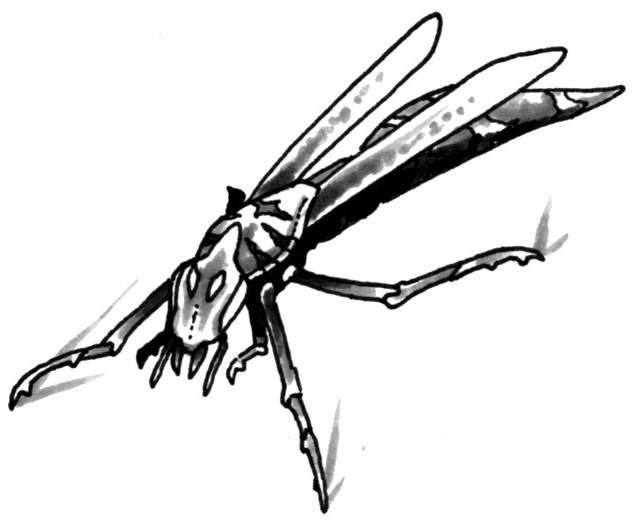Revvil
This article originally appeared in the March/April 2020 issue.
| ANIMAL | HITS | SPEED |
|---|---|---|
| Revvil | 0 (automatically killed when hit) | 15m |
| SKILLS | - | |
| ATTACKS | Foraging: Flee 6-, Attack 11+ Defending Brood: Flee 2-, Attack 5+ Bite (1) |
|
| TRAITS | Flyer; Fast Metabolism (+3
initiative) Small (-4) Poisonous (AVERAGE, 1pt + slight hallu, 1d×10 min) [Rock Revvil: Camouflage (-2 to spot in rocky areas)] |
|
| BEHAVIOUR | Omnivore/Hunter | |
| Morphology | Bilateral symmetry, decapod, quadruped (two pairs slender wings, four legs, two grasping arms), arthropod (segmented body and limbs). |
|---|---|
| Biochemistry | C/H/O/N, broadly compatible with human |
| Respiration | O2-N2 inhalant, CO2 exhalant, tracheal breathing |
| Ecology | Diurnal (active during day and twilight) |
| Habitat | wide range of warm and temperate habitats, often encountered in arid lands or steppe |
| Diet and Trophics | Omnivore/hunter, ectothermic (cold-blooded) |
| Reproduction | Two genders, very little sexual dimorphism, conjugal intercourse, oviparous birth (laying 2-10 eggs into natural cavities or excavated burrows), iteroparous (reproduce several times during lifecycle). Progeny defended until hatching. |
| Lifecycle and ontogeny | Two months to hatching, several moultings, female imago (adult form) lives for about four years. Male dies after mating. |

Revvils, also called pinkjackets, are a species of solitary burrowing insects, resembling a longish wasp of about 4cm in length, with a narrow, pink-and-purple patterned abdomen. The slender wings are opaque, shaded turquoise through purple. Although the abdomen is pointed and tapers toward an ovipositor in females, the revvil lacks a stinger. Its bite is painful, though, and its mandibles are serrated to dissect prey.
A revvil’s bite is mildly poisonous (AVERAGE END check, 1 point of damage and slight hallucinations, interval 1D×10 minutes).
Unlike Terrestrial arthropods, revvils and related species do not have compound eyes; their eyes have a central pupil spot that seems to float inside the reflective vitreous sphere. The eyeballs are stationary; the creature moves the pupil by selective contraction of different areas of the iris. The vitreous is light-sensitive and can adjust its opacity and reflectivity to ward off direct sunlight.
Small animals, mostly other arthropods and diminutive mammals, are the favoured prey of revvils. Up to mouse-sized animals can be killed with one or several bites. Anything too large to be carried off will be dissected by the sharp mandibles and brought to the brood. Not entirely carnivorous, the revvil complements its diet with gnawing fruit and leaves using a second set of mandibles.
Most of a female’s lifecycle is spent caring for its brood. It takes the larvae two months to hatch from their eggs, and the adult female spends the major part of this time gathering food and stuffing it into the tunnels where it laid the eggs, for the hatchlings to feed on. After the eggs hatch, the female will leave the brood, hunt, eat, and store protein until it is again ready to mate – which takes about two to three months.
Revvils prefer natural narrow cavities for egg-laying, but if none are available, they gnaw holes into tree bark or dig little burrows. They sometimes lay their eggs inside emptied rifle or sniper mugwort pods, which have exactly the right size for their abdomen and ovipositor to fit in. Revvils defend their eggs viciously (attack on 5+ if someone approaches the plant).
Rock Revvil
A relative of the common revvil, the rock revvil or rock wasp, lays its eggs in small rock fissures and can be dangerous to climbers if it attacks. Older buildings and ruins may also have rock revvils nesting within the cracks in their plastoconcrete. It is similar in size and behaviour to the common revvil – including the aggressive behaviour toward anyone coming near its brood – but has a reddish-gray colouring that gives it excellent mimesis in its native environment.
K’colau
| ANIMAL | HITS | SPEED |
|---|---|---|
| K’colau | 0 (automatically killed when hit) | 10m |
| SKILLS | - | |
| ATTACKS | Flee 8-, will not attack | |
| TRAITS | Flyer; Fast Metabolism (+3 initiative); Small (-4) | |
| BEHAVIOUR | Herbivore/Grazer | |
| Morphology | Bilateral symmetry, decapod, quadruped (two pairs slender wings, four legs, two grasping arms), arthropod (segmented body and limbs). |
|---|---|
| Biochemistry | C/H/O/N, broadly compatible with human |
| Respiration | O2-N2 inhalant, CO2 exhalant, tracheal breathing |
| Ecology | Diurnal (active mostly during daylight) |
| Habitat | wide range of warm and temperate habitats |
| Diet & Trophics | Herbivore/grazer, ectothermic (cold-blooded) |
| Reproduction | Two genders, very little sexual dimorphism, conjugal intercourse, oviparous birth (laying ~50 eggs in spherical community nest built in joint effort by several k’colau), semelparous (reproduce once during lifecycle). Progeny cared for until adults die. |
| Lifecycle and ontogeny | Two months as a larva, dies nine months after hatching. Larvae hibernate if necessary and hatch when temperatures rise again. Nests are deserted and built anew every year. |
Unrelated to the revvil, but very similar in appearance, is a flying arthropod called a k’colau. K’colau imitate the revvil’s characteristic paper-rustle flying sound, to protect themselves from predators, most of which give the poisonous and aggressive revvils a wide berth. Except for their annoying habit of gnawing wooden structures (they pulp the wood to create beautifully filigreed spherical paper nests), K’colau are harmless. Adults care for their young but do not defend their nests. The nests are rarely disturbed by animals because the larvae are coated with a poisonous mucous (akin to ricin) that causes intestinal inflammation.
 Freelance
Traveller
Freelance
Traveller